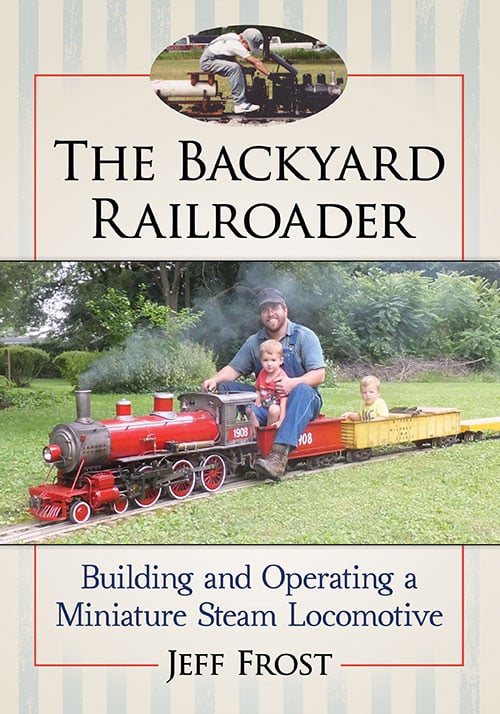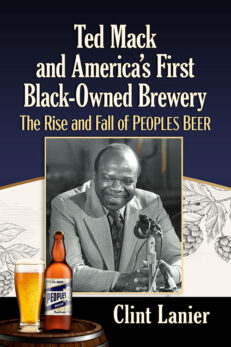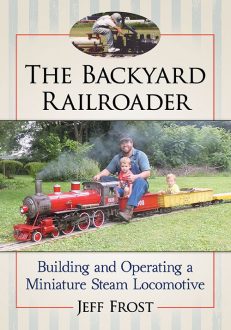The Backyard Railroader
Building and Operating a Miniature Steam Locomotive
$49.95
In stock
About the Book
Steam locomotives dominated the railways from the 1820s through the 1960s. Today almost all of them have been replaced with electric and diesel engines, yet the fascination surrounding steam-powered trains has not dwindled. A diverse community of enthusiasts—from mechanics to teachers to lawyers—have taken up the hobby of building and running steam locomotives in their own backyards. Drawing on the author’s extensive experience and research, this guide covers the materials, tools, skills and technical information needed to get started or to improve an existing design.
About the Author(s)
Bibliographic Details
Jeff Frost
Format: softcover (7 x 10)
Pages: 306
Bibliographic Info: 358 photos, appendices, index
Copyright Date: 2019
pISBN: 978-1-4766-7281-6
eISBN: 978-1-4766-3164-6
Imprint: McFarland
Table of Contents
Preface 1
Abbreviations 4
Safety Is Rule No. 1 5
Basic Machine Shop Safety 5
Basic Welding/Torching Safety 5
Basic Safety with the Track and Riding 6
Basic Safety with Running Trains 6
Safety Summary 7
Getting Started 8
To Buy or to Build? 8
Buying a Steam Engine 11
Casting Kit versus Building from Scratch 13
Track Basics 24
Book Knowledge versus Experience 29
Suppliers 31
Operating a Steam Engine 35
Basic Checklist for Operating My Steam Engines 35
Water Level in the Boiler 38
Basics of Coal Burners 38
Basics of Oil Burners 40
Sanding the Flues 42
Basics of Propane Burners 43
Firing by Landmarks 43
Speed 44
Water Behavior in the Boiler 45
Carry Over versus Foaming 47
Hooking Up an Engine 49
Hooking Up, Compression and Knocking in the Rods 52
Boilers 54
Water Glass Safety 55
Water Treatment 63
Fusible Plugs 64
Boiler Anodes 65
Boiler Washes 65
Water Circulation in the Boiler 70
Stored Energy in the Boiler 71
Lessons from Gettysburg 73
Signs and Dangers of Low Water 74
Valve Gear 75
Dead Centers 75
Lap and Lead 78
Setting Stephenson Valve Gear 79
Setting Walschaert Valve Gear 83
Inside versus Outside Admission versus Indirect Motion 93
Steam Blowing through the Piston and Valves 95
Uneven Exhausts (Out of Square) 96
Adjusting the Valve Gear on the 4-6-0 98
Building Walschaert Valve Gear for the 4-6-0 101
Lead and Lap/Combination Lever 108
Rebuilding the Valve Gear 110
Systems, Improvements and Why Things Are Done in Certain Ways 112
Potential Reasons for a Poor Steaming Engine 112
Helping an Engine Become a Better Steamer 113
Firebox Arch 114
Large Scale Atomizers 119
Drafting 123
Personal Experience with Axle Pumps and Injectors 128
Tires 132
Automatic Cylinder Cocks 136
Replacing a Crank Pin … and Then Some 139
Piston Problems and Lessons in Threading 147
When There Is No Water in the Glass … Some Food for Thought 151
Revisiting Retubing the Mikado 152
Making an 0-4-0 into a 2-4-0 158
Equalizing 164
Lubrication for the Cylinders 167
Throw, Quarter, Side Rods and Such 170
Wheels and Trucks 172
Basic Lights 174
Dynamo 177
Grates and Ashpan 180
Learning Oil Firing on a 15″ Gauge 4-4-2 185
Propane 192
Long Track, or a Short Loop 195
The Bigger the Better, Right? 195
Equalized Brakes 196
Sanders on the 2-4-0 207
My Experiences in the Hobby 212
The Shay 212
The 0-4-0/2-4-0 214
The Mikado 216
The Ten-Wheeler 219
General Improvements 221
Leaving Home 222
Our Engines 223
Rebuilding the Spirit of Traverse City 233
Getting Back into the Hobby 247
Introducing People to the Hobby 264
Appendix A. Major Parts of a Steam Locomotive 273
Appendix B. Common Questions 275
Appendix C. Common Myths 286
Appendix D. Inspections 290
Appendix E. Tractive Effort and What an Engine Can Pull 294
Index 297





